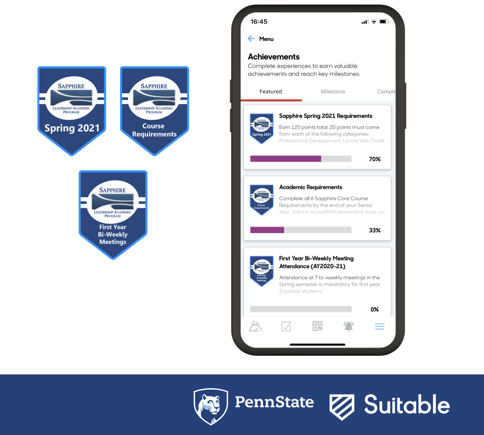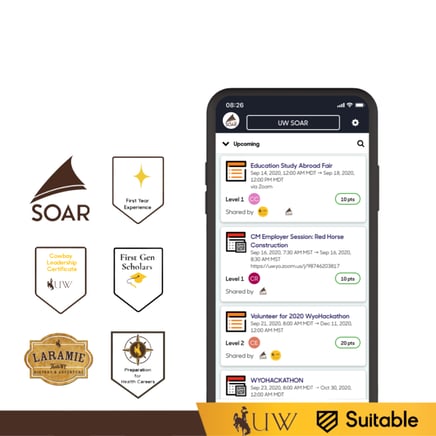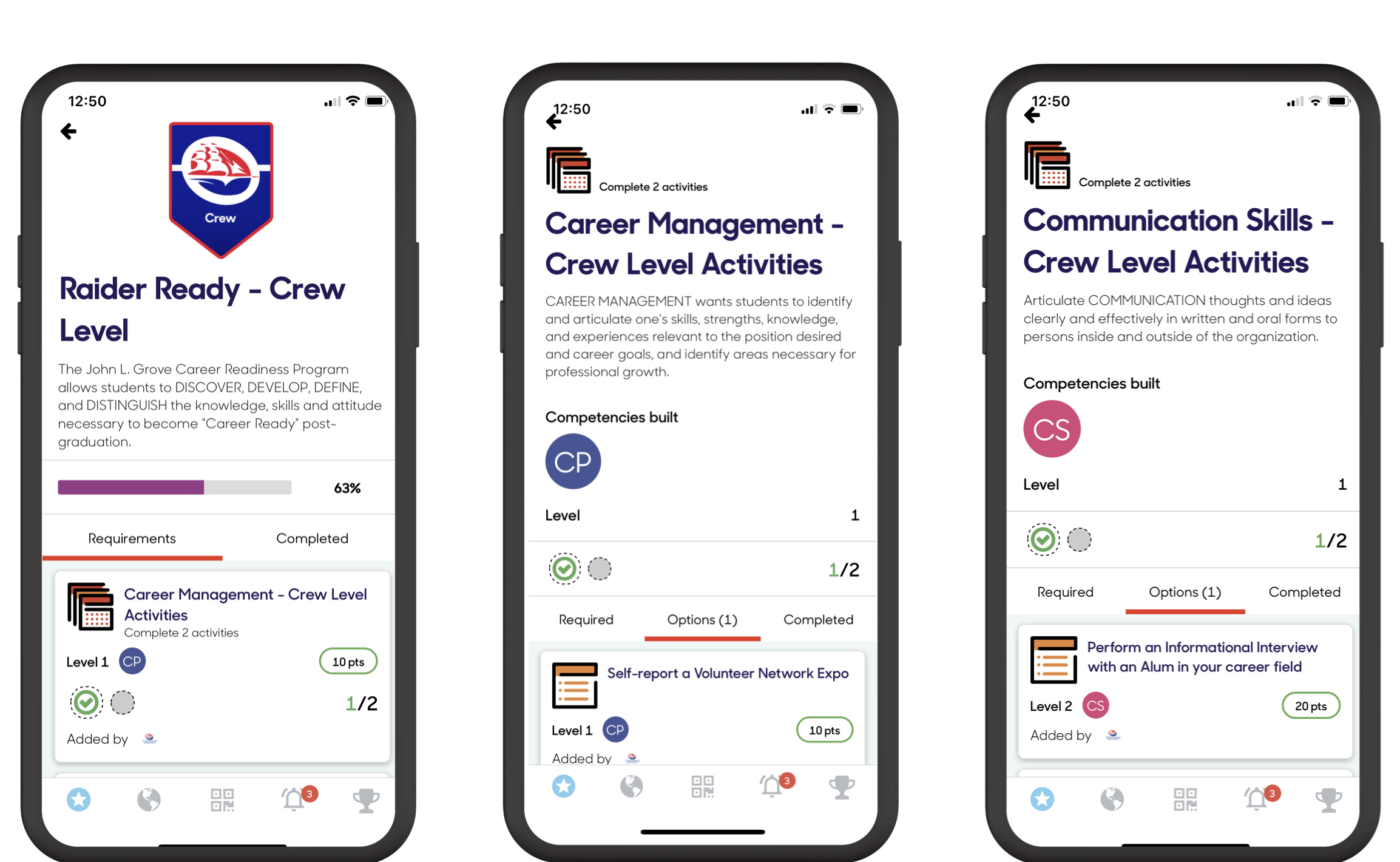.png?width=800&name=Blog%20Banners%20(6).png)
Table of Contents:
Whether you are just starting a new initiative or reimagining what you currently have, branding is the first of five pillars of student development and a very important aspect of any Suitable implementation.
To get you started in your branding process, we have compiled 10 Do’s and Don’ts for creating memorable student success branding.
What We’ll Cover:
- How to develop a strategic and unique brand name.
- Useful ways to design your brand with logos and badges that are engaging for students.
- Things to avoid when branding your program that can lead to poor program performance.
Why Is Branding So Important?
Branding sets your school up for success by setting you apart from the competition. Brand decisions are an integral part of how students will use your platform and in making sure they are engaged with the program.
When it comes to higher education, many administrators think of branding as a nice-to-have, an afterthought, or even worse, a distraction.
Nothing could be further from the truth. There are many benefits to quality branding in student programming that will make your initiatives exponentially more successful.
Adoption & Engagement
Time and again, when we speak to college and university administrators about the challenges they face creating student success initiatives, they tell us that they created a program but no one used it. While there can be many reasons for this, the main takeaway is “it just never caught on.”
And that’s when we begin to wonder: how was this program introduced to students?
When schools begin with Suitable right from orientation, the goal for any administrator is to make students excited about their new school and the value-add of programs like those created with Suitable.
This is where branding is so important. By making the brand messaging of your program consistent with school mottos, iconography, colors and more, you are reassuring students that the reasons they fell in love with the school in the first place are consistent in quality throughout all the school’s initiatives–inside the classroom and out.
Trust
Whenever colleges and universities partner with outside technology (instead of building their own), there can be gaps between the school’s native technology and the partner. This can create confusion, a disjointed user experience and a lack of confidence in the technology.
All of this leads to students becoming less engaged or ignoring the technology altogether.
By keeping branding, data integration and design consistent across all user-facing interfaces, you improve that trust among students that their data is secure, that the technology is fully supported by the school and even that there are no gaps between native school technology and technology partners. All of this leads to higher user engagement and increased student satisfaction.
School Promotion
When schools work with Suitable, we encourage them to explore core competencies and how those competencies are mapped toward a school’s identity. What do you want students to graduate with and how do these core focus areas shape who you are?
By creating a program that systematically maps out each student’s journey toward these competencies, you clearly show not only what your school’s values are but how you will guide each student to them.
Carefully branding these programs as an extension of your school’s mission makes them a clear value to anyone considering your university. Good branding can make your program an essential part of a school’s pitch to prospective students as to why you will make a great partner, from convocation to commencement.
10 Do’s & Don’ts
Because higher education brand messaging is so essential to your next Suitable initiative, it can be hard to know where to begin. So we came up with a few Do’s and Don’ts to get you started.
I. Don’t create your brand first
Most institutions make the mistake of making their brand first. Sometimes, we can become attached to our first idea, but remember you’re not married to it. Allow your brand to develop! Being set on a specific brand can lead to adverse programmatic decisions to make that brand name work. You don’t want to exclude an experience or activity because it doesn’t “fit the brand” that you are hoping to use.
Instead, we recommend letting your program’s goals and everything you put together on Suitable really inform what the brand should be. It's ok to have a working brand name, but it is important to be open to changing it to be more appealing. As your institution and students’ needs change, you will have to, as well.
II. Use your school’s uniqueness to inform your brand
We commonly see schools create pathways called “Career Readiness Program” or “Professional Development Initiative” and although they explain what the program is, titles like these make it difficult to generate excitement from students. Get creative by aligning your brand with your school’s name, mascot, or something unique on campus that students are aware of. Use that to inform your brand.
Here are a few of our favorites from our partners:
-
University of North Carolina Greensboro: Bryan Gold
-
University of Alabama: UA Business Lead
-
Montclair State University: Experience Montclair
III. Don’t create a lengthy brand name
Your brand name should roll off the tongue. As a test, try to say your brand name 10 times, as fast as you can. Having a short, sweet and catchy name will help it stick with your students, further engaging them.
Having a long program name may seem more descriptive, but in reality, students are more likely to recall a shorter name. For example, one of our partners started a program with the name “The Bryan School of Business Gold Standard” which got shortened to “Bryan Gold”– short and sweet.
IV. Use acronyms to shorten your brand name when needed
An acronym works great to shorten a brand name, especially if that acronym is actually a word. A great example of this is Rutgers Engagement and Leadership Development, which they shortened to Rutgers REAL. Trust us, your students will thank you for it.
V. Don’t leave things too open-ended when collecting feedback
Collecting feedback is a great way to see what faculty and students think about the new initiative. Rather than asking “What should our brand be called?”, try to narrow down the possibilities to your favorite three brand names. This can help to focus the conversation and provide more constructive feedback.
VI. Create a unique brand logo
A lot of times schools just want to use their school logo for their program on Suitable. If you really want your pathway on Suitable to be a signature initiative, consider creating a logo that ties together everything you’re trying to do with visual representation. Also, there will be less red tape because you're not using a school logo, which may restrict you from creating the content you want.
Keep the mobile experience in mind– make sure your logo is visible and legible on mobile devices. Don’t forget that your desktop view translates differently on mobile platforms. Make sure you’re testing both iOS and Android as content can show up differently depending on which type of phone each student has.
Take a look at Penn State's Sapphire Program, for example.

Penn State’s Sapphire program’s platform is a perfect example of this. Penn State uses its sleek Sapphire logo across its badges on the app. Using this program-specific logo helps distinguish it from the rest of the school, allowing more room for specific content under this branch and creating continuity. This logo also looks great on mobile devices, both iOS and Android.
VII. Connect your logo and badges visually
When you create a unique program logo, try to also create a badge template that connects your logo to achievement badges that students are going to be working towards. When a student is looking at your logo or any badges in the system, they should automatically know that it's part of one unified initiative. This will help keep your students organized and on track.
In the same light as uniting your logo and your achievement badges, you can actually unite your achievement badges together, especially if they are stackable badges. Try to allow a student to visually understand that this smaller badge is related to their bigger badge that it stacks into. You can use the same template, different colors. This is a really effective way to generate excitement because if a student can visualize what the next step is, they’ll be more motivated to get there.
Check out University of Wyoming’s badges:

University of Wyoming’s career-readiness program, called SOAR, is campus-wide, reaching every student. UW also has their First-Year Experience and First Gen Scholars badges, which are tailored to work alongside each other and other badge programs like SOAR, creating an overall competency program to get students closer to their career goals.
VIII. Don’t let perfection get in the way of a good brand
We often see schools that really want to have the greatest brand ever created. In many cases, that is the ultimate enemy of coming up with an effective and successful brand. Try to keep your planning group smaller; otherwise, there may be too many opinions and you risk not ever getting anything done.
You may not get your brand name right at first, but Suitable makes it really easy to adjust. Don’t let the name get in the way of launching to students. Once you launch, you'll be able to gauge student perceptions. Our University Success team can help you figure out what is a good brand to launch with, and then how to iterate on that brand moving forward.
IX. Don’t forget about the 5 Pillars of Student Development
- Brand
One of the first that you should tackle but it doesn’t just end at having a great brand. Our most successful implementations have 5 common characteristics that drove the success of their initiative. The first is a brand with a unique name and modern visuals.
- Awareness
Make sure students know about the program. The awareness process should incorporate many tactics to gain awareness with as many students as you can. 3. Value
Articulate why students should participate in the program. For example, to develop skills and improve their career success after graduation. Many schools use their competency-based framework to communicate the value to students because recruiters already use competency-based recruiting models when hiring interns and entry-level positions.
- Scale
Start small with your incoming freshmen class or one college. In some cases, staring big too quickly can hinder the momentum of everything you've done. Starting small can also provide insights on how to scale up with less obstacles.
- Assessment
Use Suitable data to inform how to continuously improve as a school. Suitable makes it easy to assess both the program and the competency development of students. This makes for a comprehensive and truly valuable program.
X. Have fun with it!
Creating a brand for your students to enjoy should really be a creative and stress-free process. We hear from schools a lot that they actually look forward to the Suitable planning meetings during implementation. Schools enjoy diving deep and figuring out what they want to do and what their brand should be. Hereat Suitable, we also enjoy rolling up our sleeves and helping out as well!
Take a look at Providence University’s app. Shippensburg’s app is fully interactive, engaging and to the point. Students have been engaging with this program for almost three years, and have seen tremendous growth in student engagement. With our intuitive design, visually striking badges and activities, and easy-to-use app, 97% of students engaged with our app in the Fall of 2019.

To get inspiration and great examples of all these Dos and Don’ts, we highly suggest that you check out our Pathways award-winning program brands. You may have heard the term “we don’t want to reinvent the wheel”– well, you don’t have to! Many of our partners have developed unique and visually representative brands that can be a great help to your journey:
-
College of Charleston- QUEST
-
Georgia Tech- Charge
-
Kennesaw State university - Flight Academy
-
Shippensburg University -Raider Ready
-
University of Arkansas- S.A.M.


-1.png)